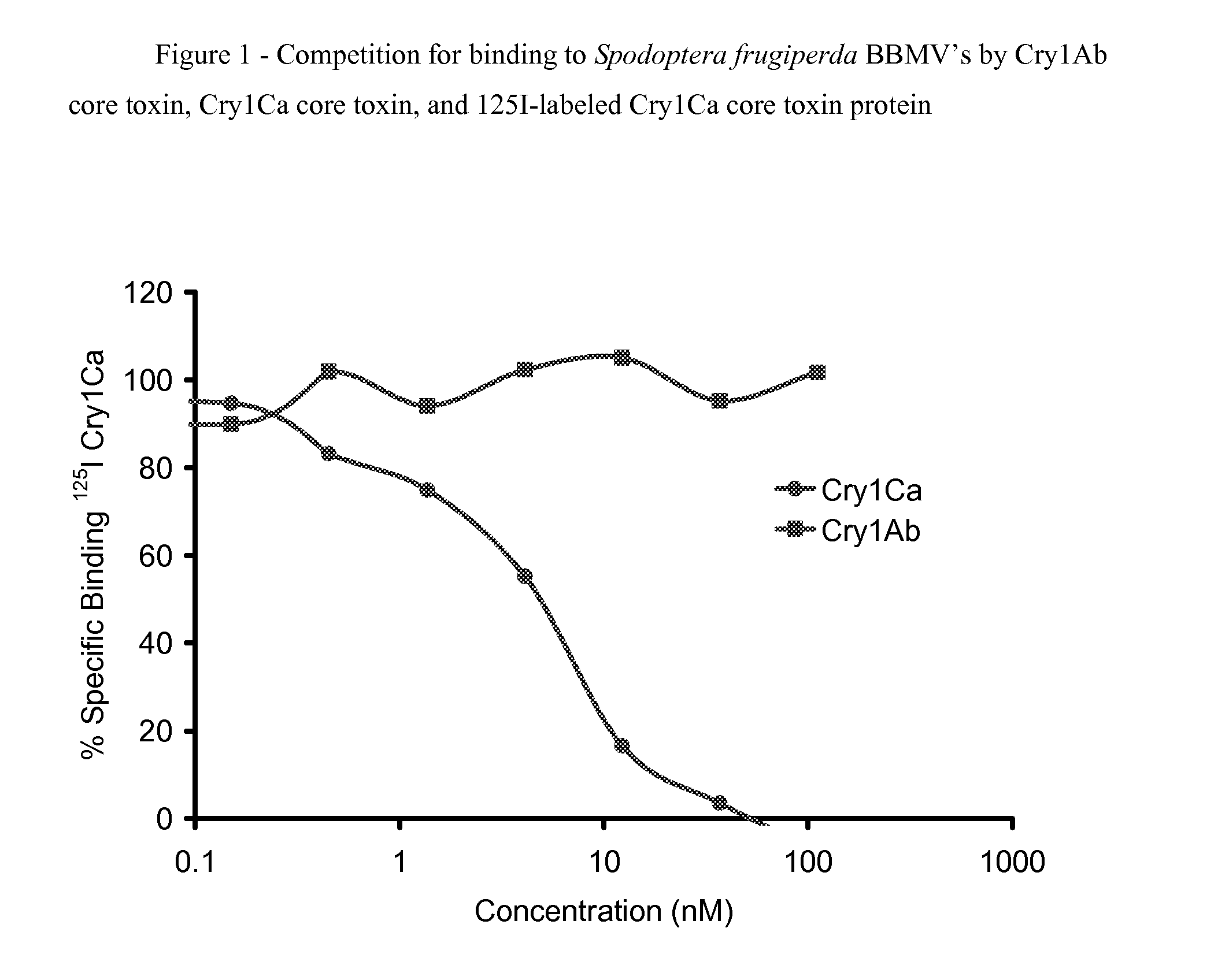Combined use of cry1ca and cry1ab proteins for insect resistance management
a technology of insect resistance and protein, applied in the field of insect resistance management, can solve the problems of additional billions lost to the damage caused by the insect resistance, and undermine the human effort, and achieve the effect of preventing or delaying the development of resistan
- Summary
- Abstract
- Description
- Claims
- Application Information
AI Technical Summary
Benefits of technology
Problems solved by technology
Method used
Image
Examples
example 1
Design of Chimeric Toxins Comprising Cry1Core Toxins and Heterologous Protoxins, and Insecticidal Activity of Dig-152 Protein Produced in Pseudomonas fluorescens
[0094]Chimeric Toxins.
[0095]Chimeric proteins utilizing the core toxin domain of one Cry toxin fused to the protoxin segment of another Cry toxin have previously been reported, for example, in U.S. Pat. No. 5,593,881 and U.S. Pat. No. 5,932,209.
[0096]Cry1Ca chimeric protein variants of this invention include chimeric toxins comprising an N-terminal core toxin segment derived from a Cry1Ca3 insecticidal toxin fused to a heterologous delta endotoxin protoxin segment at some point past the end of the core toxin segment. The transition from the core toxin to the heterologous protoxin segment can occur at approximately the native core toxin / protoxin junction, ora portion of the native protoxin (extending past the core toxin segment) can be retained, with the transition to the heterologous protoxin occurring downstream. In varian...
example 2
Construction of Expression Plasmids Encoding Chimeric Proteins and Expression in Pseudomonas
[0115]Standard cloning methods [as described in, for example, Sambrook et al., (1989) and Ausubel et al., (1995), and updates thereof] were used in the construction of Pseudomonas fluorescens (Pf) expression construct pMYC2547 engineered to produce a full-length DIG-152 chimeric protein. Protein production was performed in Pseudomonas fluorescens strain MB214 (a derivative of strain MB101; P. fluorescens biovar I), having an insertion of a modified lac operon as disclosed in U.S. Pat. No. 5,169,760. The basic cloning strategy entailed subcloning a DNA fragment encoding DIG-152 into plasmid vectors, whereby it is placed under the expression control of the Ptac promoter and the rrnBT1T2 terminator from plasmid pKK223-3 (PL Pharmacia, Milwaukee, Wis.). One such plasmid was named pMYC2547, and the MB214 isolate harboring this plasmid is named Dpf108.
[0116]Growth and Expression Analysis in Shake ...
example 3
Preparation of Cry1Ca and Cry1Ab Core Toxin Proteins and Isolation of Spodoptera frugiperda Brush Border Membrane Vesicles for Use in Competitive Binding Experiments
[0130]The following examples evaluate the competition binding of Cry1 core toxin proteins to putative receptors in insect gut tissues. It is shown that 125I-labeled Cry1Ca core toxin protein binds with high affinity to Brush Border Membrane Vesicles (BBMV's) prepared from Spodoptera frugiperda (fall armyworm) and that Cry1Ab core toxin protein does not compete with this binding. In the alternative, it is shown that 125I-labeled Cry1Ab core toxin protein binds with high affinity to BBMV's prepared from S. frugiperda and that Cry1Ca core toxin protein does not compete with this binding.
[0131]Purification of Cry Proteins.
[0132]A gene encoding a chimeric DIG-152 protein, comprising the Cry1Ca3 core toxin and Cry1Ab protoxin, was expressed in the Pseudomonas fluorescens expression strain as described in Example 2. In similar ...
PUM
| Property | Measurement | Unit |
|---|---|---|
| concentration | aaaaa | aaaaa |
| RH | aaaaa | aaaaa |
| resistance | aaaaa | aaaaa |
Abstract
Description
Claims
Application Information
 Login to View More
Login to View More - R&D
- Intellectual Property
- Life Sciences
- Materials
- Tech Scout
- Unparalleled Data Quality
- Higher Quality Content
- 60% Fewer Hallucinations
Browse by: Latest US Patents, China's latest patents, Technical Efficacy Thesaurus, Application Domain, Technology Topic, Popular Technical Reports.
© 2025 PatSnap. All rights reserved.Legal|Privacy policy|Modern Slavery Act Transparency Statement|Sitemap|About US| Contact US: help@patsnap.com


